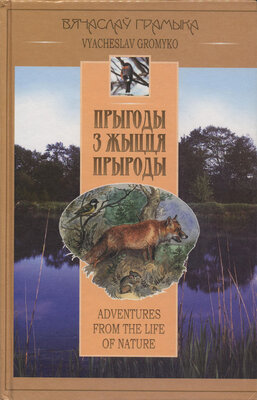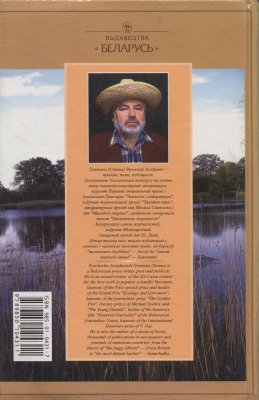Прыгоды з жыцця прыроды
Adventures from the life of nature
Вячаслаў Грамыка
Выдавец: Беларусь
Памер: 263с.
Мінск 2003
During the period of student practice, when I managed to escape to Minsk for a day and then, on my way back, reached Dovbeny by bus and walked further on foot, to our permanent post, I was always given a lift by the first passing car or a cart.
Once, in the cabin of a passing empty timber lorry (you can hardly sit anywhere else, but in the cabin) there were five of us with the driver altogether. Today I am even surprised how I could shut the door behind me, since 1 was the last one to crawl into the lorry. We sat one upon the other, bent and compressed as it was only possible. We could scarcely squeeze into, but everyone thought that it was convenient and all were satisfied.
There we were in the virgin forest with its own laws and it is known that the more tough living conditions are, the better a man himself can be seen, the stronger all his traits of character are revealed, particularly such as humaneness and kindness. I think that the amazing and rich nature of Nalibokskaya area has transferred to local residents its beauty and wealth.
My friends-chemists also liked these places. We bathed very long in the little Islach where it was deeper a bit, usually in backwaters. In other places it was no deeper than to our knees. The banks were low, slightly steep from one side and gradual, sloping, with soft yellow sand from the opposite. The three of us were playing soccer on the bank, bathed in the sun. In the evening we admired a row of woodcocks tardy for that time.
Since I mentioned woodcocks, I'd like to deviate from the topic and relate about them.
These mysterious forest birds have started to perform their spring courtship rituals. They flew one after the other, couple after couple, so beautifully and successfully fitting the environment that our unity with nature seemed to be even stronger...
I failed to understand why their mating started now, at the end of June, when nestlings had been hatched already. Perhaps it was a repeated one, another mating? Sometimes it happens when the first hatches are early ones and the young begin to live independently very quickly.
But it is a great desire to tell more in detail about the amazing forest weevil whom you are always glad to meet. Its spring courtship ritual or, as hunters and specialists call it, “dragging” — is, perhaps, the most tender and poetical moment in the whole rich and diverse life of the Belarussian nature.
Woodcock is a special bird. This is the only representative of the large family of sandpipers, which lives in the forest. The rest
of its relatives mostly inhabit swamps and at times — steppes. Woodcock is a small bird, not bigger than a pigeon, sometimes even smaller, but it has a nose that none of the forest inhabitants have — about five times longer than its head. But ”'hat a good instrument for the search of worms and grubs it is! With the help of it the bird can get food at great depth of the forest ground. Woodcock has special small sensitive prominences at the end of its beak; with their help the bird can feel its prey even under the ground. In wild nature a woodcock seems to be very beautiful and graceful bird in spite of its long nose and weird eyes, which help the bird to see what is going on behind it. The bird is, undoubtedly, beautiful and taking into consideration that it is the only representative of all the sandpipers, which lives in the forest, is also unusual.
Normally a woodcock is of ochre-red color with some shade of grayish. The front part of its head is all grey. The back of the head and the upper part of the neck are colored in four black-greyishbrown or deep red stripes, the neck is whitish and most of the body is of light yellow-grey color. It looks as if the sandpiper put on a camouflage cloak. If it sits down on the grey grass covered with the last year leaves, no one will ever find it there, and, besides, the sandpiper prefers backwoods.
The woodcock leads a most mysterious life. In the daytime it hides in the thickets among the fems and young aspens and alders. It stays there the whole day. Only when a fox or some other beast of prey appears, it will take off and find another hiding place; and no flying enemy can notice the woodcock among the gray grass, thickets and the ground where it sits motionlessly.
At night the woodcock is active. It runs quickly on the soft forest ground. When feeling something it puts down its long nose into the ground. Then it gets it out and examines what he has got — an earthworm. The sandpiper would throw it up, catch it deftly in the air with the very tip of the long beak, swallow it and run farther on. It would turn over a leaf or a piece of bark, without stopping, just like a gatherer of mushrooms does it with a stick, then it would touch a stalk, find a slug, swallow it and run forward again... Worms, various grubs, insects and other small fry, which are found in the upper layer of the ground, are the main food for
the woodcock. Sometimes the woodcock eats even young grass roots and it happens to visit the fields where it can find sprouts of rye or winter wheat.
The woodcock is a migrant bird; it comes back home very early when snow only begins to melt. At this time the bird keeps to the mixed forest mainly as it likes low aspen woods, and you can come across it near coppices and roads, small forest rivers, on broad glades and the places of former fires.
Its marriage play or spring courtship ritual takes place in the air. It begins in the evening at sunset... At the very moment the sun sets light shadows they, one by one, begin to rush by in their favorite places above the tops of the trees. These are male woodcocks, which have risen as if by a command and are flying now easily and gracefully — “drag” above the forest looking for female woodcocks.
“Tzvi-tzvi! Khur-khur... Tzvi-tzvi! Khur-khur...” you can hear these calls from different corners.
So it usually happens in early spring when first thawed patches and turbulent springs appear. Perhaps, that is the true explanation of the harmony and beauty of the woodcock's spring flight in the general picture of spring in our forest. When you recollect either spring in the forest or a woodcock's flight in mating season you are at once with the other one, as if the sequel of a fairy action of the first light and blossom.
But as we have already mentioned, June was in full blossoming, but that didn't discourage the sandpipers. They would fly and fly above the hollow of the century-old forest made by low trees and bushes over a small forest river. They would fly slowly with downcast heads looking closely and searching female woodcocks.
From time to time they would start fighting with one another, but those fights were not long. The rivals would fly apart in different directions. Some of them would stop flying for a moment as if hanging in midair, flapping their wings and circling above one place for some time. Then they would dive over the tops of the trees and hang in midair again.
Suddenly a light whistle was heard nearby. Something dark took off not high from the ground. One of the displaying
males immediately rushed down and in a moment the two shadows hid on the ground. One male woodcock was lucky already — a female woodcock gave a sign herself and called him. The displaying flights of woodcocks lasted till the very dark and even when it was impossible to make out the birds' silhouettes in the dark sky, rare appeals, which became even more expressive in the quiet of the night, could be heard from one side or another.
Even my friends, who were neither specialists in ecology nor ornithologists, were greatly impressed by the night flights of woodcocks in mating season. They exchanged their impressions energetically and questioned me about more details of life of these mysterious birds, which they had never seen before.
Meanwhile, we hurried to reach the ruins of Count Tyshkevich's castle before midnight. The castle was about 8 kilometers from our camp. I told the fellows that at night the ruins were visited by a ghost. The ghost climbed to the first floor and on a starry summer night one could see him well. Though my companions didn't believe my story, they decided to go there.
The castle is in the place where Islach becomes wider and full and it is situated on the high river bank in the vast area planted with age-old oak trees.
When I was a student we often visited the place during our practical training, not only in the daytime but also at night. It was an impressive two-story building with broad brick walls where the plaster crumbled out and here and there bricks crumbled out too, only the mortar was not damaged at all. It was hard and strong and appeared to keep forever. Up to the present time, nobody can find out the secret of this mortar. Its analogues made nowadays cannot be compared with it. I wonder how people of that time could do it when there were no modern building materials, paints and other chemical substances and equipment. One more fact: they lived in such a remote place where it was difficult to get and prepare great quantities of mortar at the building site, and the mortar had to be of the highest quality. Up to the present moment the castle stands there surprising and impressing us as if it had been built for that purpose in this remote place. Only one thing is known exactly — the composition of the mortar included hens'
eggs, which had been collected all round the neighborhood at the time of construction.
No, certainly the castle was built not for the descendants, not to surprise and imp-ess them. It was in the very backwoods of the Nalibokskaya virgin forest, which was rich in wild animals. It was the public merrymaking ground for Count Tyshkevich and his suite. Magnificent hunts followed one another at that time. There were lots of wild animals then. After the hunts the Count and his suite would amuse themselves in luxurious chambers till late night. So this magnificent castle was built just for such entertainments, which lasted only a few days a year.
 КНІГІ ОНЛАЙН
КНІГІ ОНЛАЙН


